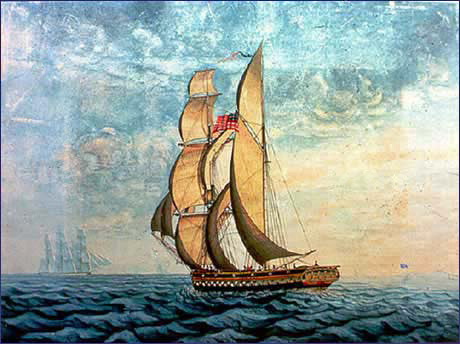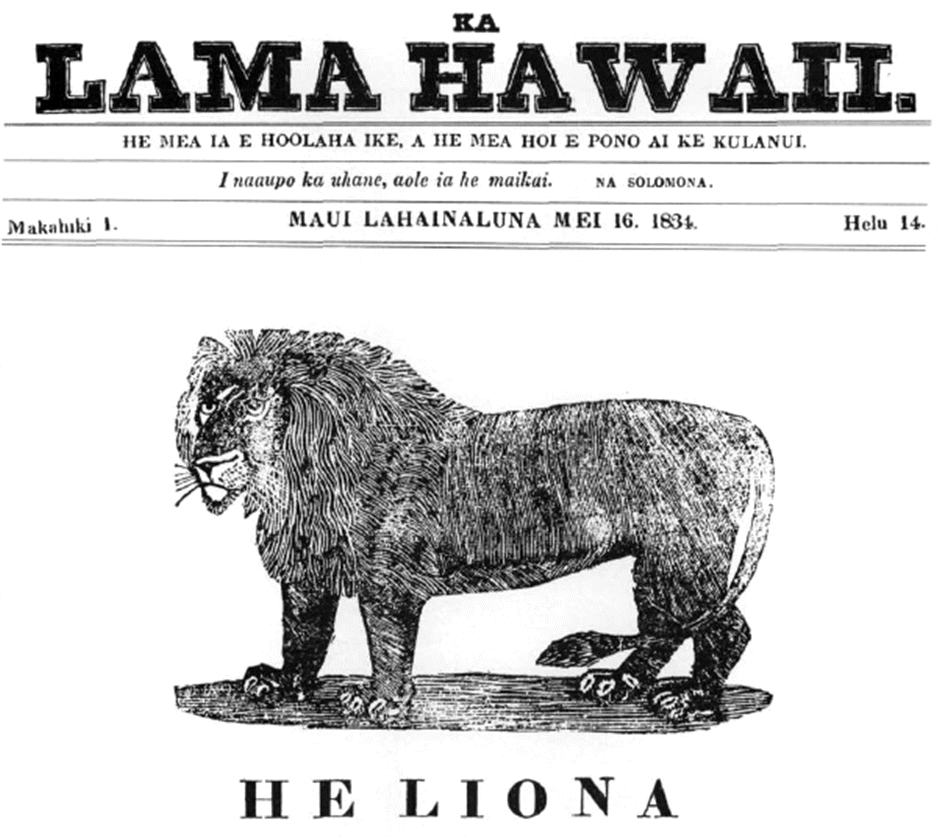|
Kuini Liliha
Kuini Liliha (–1839) was a High Chiefess (aliʻi) and noblewoman who served the Kingdom of Hawaii as royal governor of Oʻahu island. She administered the island from 1829 to 1831 following the death of her husband Boki. Early life She was born in 1802. Her father was Ulumāheihei Hoapili, a son of Kameʻeiamoku, one of the ''nīʻaupiʻo'' (highest noble rank) twin brothers. Her mother was High Chiefess Kalilikauoha of Maui, who was the daughter of King Kahekili II of Maui and his half-sister bride Luahiwa. Some genealogists say Liliha was only adopted by Hoapili, but the practice known as ''hānai'' was considered a bond as strong as a blood relation. According to them, she was the biological daughter of Koakanu, a son or grandson of Kaolohaka-a-Keawe, one of the many issues of Keaweʻīkekahialiʻiokamoku; and his wife High Chiefess Loeau. Her name means "heartsick queen" in the Hawaiian language. She had no siblings. Liliha was initially married to Kahalaiʻa Lua ... [...More Info...] [...Related Items...] OR: [Wikipedia] [Google] [Baidu] |
Measles
Measles is a highly contagious infectious disease caused by Measles morbillivirus, measles virus. Symptoms usually develop 10–12 days after exposure to an infected person and last 7–10 days. Initial symptoms typically include fever, often greater than , cough, Rhinitis, runny nose, and conjunctivitis, inflamed eyes. Small white spots known as Koplik's spots may form inside the mouth two or three days after the start of symptoms. A red, flat rash which usually starts on the face and then spreads to the rest of the body typically begins three to five days after the start of symptoms. Common complications include diarrhea (in 8% of cases), Otitis media, middle ear infection (7%), and pneumonia (6%). These occur in part due to measles-induced immunosuppression. Less commonly seizures, blindness, or encephalitis, inflammation of the brain may occur. Other names include ''morbilli'', ''rubeola'', ''red measles'', and ''English measles''. Both rubella, also known as ''German measl ... [...More Info...] [...Related Items...] OR: [Wikipedia] [Google] [Baidu] |
George IV
George IV (George Augustus Frederick; 12 August 1762 – 26 June 1830) was King of the United Kingdom of Great Britain and Ireland and King of Hanover from the death of his father, King George III, on 29 January 1820, until his own death ten years later. At the time of his accession to the throne, he was acting as Prince Regent, having done so since 5 February 1811, during his father's final mental illness. George IV was the eldest child of King George III and Queen Charlotte. He led an extravagant lifestyle that contributed to the fashions of the Regency era. He was a patron of new forms of leisure, style and taste. He commissioned John Nash to build the Royal Pavilion in Brighton and remodel Buckingham Palace, and commissioned Jeffry Wyatville to rebuild Windsor Castle. George's charm and culture earned him the title "the first gentleman of England", but his dissolute way of life and poor relationships with his parents and his wife, Caroline of Brunswick, earned h ... [...More Info...] [...Related Items...] OR: [Wikipedia] [Google] [Baidu] |
Kamāmalu
Kamāmalu Kalani-Kuaʻana-o-Kamehamalu-Kekūāiwa-o-kalani-Kealiʻi-Hoʻopili-a-Walu (–1824) was Queen consort of the Kingdom of Hawaiʻi as the wife of King Kamehameha II. Kamāmalu was short for Kamehamalu or Kamehamehamalu meaning "the Shade of the Lonely One", honoring her father, "the Lonely One". She is not to be confused with her niece, Princess Victoria Kamāmalu. Life She was the eldest daughter of Queen Kalākua Kaheiheimālie and King Kamehameha I. She was referred to as Kekūāiwa for the early part of her life. According to John Papa ʻĪʻī, she was betrothed to her half-brother Kamehameha II from birth and they were married when she was twelve and he was seventeen or eighteen. Her younger sister Kīnaʻu later also became wife of Kamehameha II as did their half-sister Kekauluohi by their mothers Kalakua Kaheiheimalie. Even though her husband had four other wives (two of them her sisters and the two others her nieces), Kamāmalu was her husband's favorite wi ... [...More Info...] [...Related Items...] OR: [Wikipedia] [Google] [Baidu] |
Kekūanāoʻa
Mataio Kekūanaōʻa ( – November 24, 1868), formally referred to as His Honor or His Highness, was a Hawaiian politician who served as governor of the island of Oahu, father of two kings, Kamehameha IV and Kamehameha V, and held the office of Kuhina Nui as did his wife, Kīnaʻu and their daughter, Victoria Kamāmalu. His first name is the Hawaiian form of Matthew. Kekūanaōʻa translates as "the standing projection" in the Hawaiian language. Parentage and early life Kekūanaōʻa was born sometime around the year 1791. His mother is believed to be Inaina. While an obituary at his death identified his father as Nāhiʻōleʻa, on March 14, 1879 the Hawaiian Supreme court identified Kiʻilaweau as the father of Kekuanaoa in probate using the genealogy books of the royal family, proving a legal bloodline line from Keʻelikōlani back to Kiʻilaweau's grandmother, Moana. John Papa ʻĪʻī's uncle Nāhiʻōleʻa, the aliʻi that took Kalanikapule's side against Kamehameha I ... [...More Info...] [...Related Items...] OR: [Wikipedia] [Google] [Baidu] |
Their Majesties King Rheo Rhio, Queen Tamehamalu, Madame Poke
In Modern English, ''they'' is a third-person pronoun relating to a grammatical subject. Morphology In Standard Modern English, ''they'' has five distinct word forms: * ''they'': the nominative (subjective) form * ''them'': the accusative (objective, called the 'oblique'.) and a non-standard determinative form. * ''their:'' the dependent genitive (possessive) form * ''theirs'': independent genitive form * ''themselves'': prototypical reflexive form *''themself'': derivative reflexive form (nonstandard; now chiefly used instead of "himself or herself" as a reflexive epicenity for ''they'' in pronominal reference to a singular referent) History Old English had a single third-person pronoun '' hē'', which had both singular and plural forms, and ''they'' wasn't among them. In or about the start of the 13th century, ''they'' was imported from a Scandinavian source (Old Norse ''þeir'', Old Danish, Old Swedish ''þer'', ''þair''), where it was a masculine plural dem ... [...More Info...] [...Related Items...] OR: [Wikipedia] [Google] [Baidu] |
Kalanimoku
William Pitt Kalanimoku or Kalaimoku ( – February 7, 1827) was a High Chief who functioned similarly to a prime minister of the Hawaiian Kingdom during the reigns of Kamehameha I, Kamehameha II and the beginning of the reign of Kamehameha III. He was called The Iron Cable of Hawaii because of his abilities. Life Kalanimoku was born at Kauiki, Maui, circa 1768. His father was Kekuamanoha and his mother was Kamakahukilani, the niece of his father. Through his father he was a grandson of Kekaulike, the King or Moi of Maui. Through his mother he was great-grandson of Kekaulike. He was cousin of Kaahumanu, Kaheiheimālie, and Namahana Piia, Kamehameha's three wives; Kuakini, later served as Governor of Hawaii; and Keeaumoku II, later served as Governor of Maui. His siblings included Boki, later served as Governor of Oahu; Kahakuhaakoi Wahinepio, later served as Governor of Maui, and Manono II, the wife of Keaoua Kekuaokalani. Both his sisters were at one time wives of ... [...More Info...] [...Related Items...] OR: [Wikipedia] [Google] [Baidu] |
Likelike (wife Of Kalanimoku)
Likelike (; died March 4, 1821) was a high chiefess and member of the royal family of the Kingdom of Hawaii. Before the standardization of the Hawaiian language, her name was sometime written as Rikériki. She was the favorite wife of Prime Minister Kalanimoku, a powerful chief and statesman during the early years of the Hawaiian monarchy, and she would accompany him on his interactions with visiting Western explorers and American missionaries to Hawaii. Likelike and her newborn son Lanihau died shortly after the baby’s birth due to the shock caused by cannons fired to celebrate the royal birth. Her funeral was conducted under traditional Hawaiian customs with the exception of a Christian sermon, which was the first performed on a Hawaiian royal. Family and marriage Likelike was born to High Chief Kaikioʻewa and his wife Nahaukapu. She was considered a ''kaukau aliʻi'', a chief of lower-ranking descent, but was also a distant relative of King Kamehameha I on her father ... [...More Info...] [...Related Items...] OR: [Wikipedia] [Google] [Baidu] |
Kamehameha II
Kamehameha II (November 1797 – July 14, 1824) was the second king of the Kingdom of Hawaii. His birth name was Liholiho and full name was Kalaninui kua Liholiho i ke kapu ʻIolani. It was lengthened to Kalani Kaleiʻaimoku o Kaiwikapu o Laʻamea i Kauikawekiu Ahilapalapa Kealiʻi Kauinamoku o Kahekili Kalaninui i Mamao ʻIolani i Ka Liholiho when he took the throne. Early life Kamehameha II was born in the month of Hanaiaʻeleʻele (corresponding to November) 1797 in Hilo, on the island of Hawaiʻi, the first born son of Kamehameha I with his highest-ranking wife Keōpuolani. It was originally planned that he would be born at the Kūkaniloko birth site on the island of Oʻahu but the Queen's sickness prevented travel. Given in care to his father's trusted servant Hanapi, who took the child to rear him in the lands of Kalaoa in Hilo Paliku, he was taken back, after five or six months, by his maternal grandmother Kekuʻiapoiwa Liliha because she felt he was not getting th ... [...More Info...] [...Related Items...] OR: [Wikipedia] [Google] [Baidu] |
Hawaiian Language
Hawaiian (', ) is a Polynesian language of the Austronesian language family that takes its name from Hawaii, the largest island in the tropical North Pacific archipelago where it developed. Hawaiian, along with English, is an official language of the US state of Hawaii. King Kamehameha III established the first Hawaiian-language constitution in 1839 and 1840. For various reasons, including territorial legislation establishing English as the official language in schools, the number of native speakers of Hawaiian gradually decreased during the period from the 1830s to the 1950s. Hawaiian was essentially displaced by English on six of seven inhabited islands. In 2001, native speakers of Hawaiian amounted to less than 0.1% of the statewide population. Linguists were unsure if Hawaiian and other endangered languages would survive. Nevertheless, from around 1949 to the present day, there has been a gradual increase in attention to and promotion of the language. Public Hawaiian-la ... [...More Info...] [...Related Items...] OR: [Wikipedia] [Google] [Baidu] |




